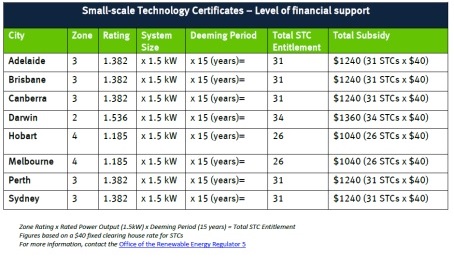FAQ
-
Get a Free Solar Quote
- CLICK HERE!
Solar industry is very well regulated in Australia. Each and every aspect from product to installation is regulated. The list is extensive but some of the major Australian Standards are:
PV & Inverter Standards
AS/NZS 5033:2005, Installation of photovoltaic (PV) arrays.
AS/NZS 5033:2005, Installation of photovoltaic (PV) arrays.
AS/NZS 5033, PV modules are compliant and the product is listed at www.cleanenergycouncil.org.au
Grid Connected Solar Electric Systems
AS/NZS 3000:2007, Wiring Rules.
AS/NZS1768:2007, Lightning Protection.
AS/NZS1768:2007, Lightning Protection
Standalone Solar Power Systems
AS/NZS 4509:2009, Standalone Power systems, Part 1: Safety & installation.
AS 4086.2:1997, Secondary batteries for use with standalone power systems, Part 2: Installation & maintenance, wind system. AS/NZS 3000:2007, Wiring Rules
A solar system can help you reduce your bill substantially and in some applications like off grid systems, reduce your bill to zero. In Australia with Net Metering (explained later in FAQ’s), the electricity produced though your solar system is fed directly during the daytime into your home, office or commercial enterprise. This helps you to substantially offset your consumption which you would have paid for. The bigger the system the more likely you will be that power you generate and do not use will be fed back into the grid.
The payment for this electricity you generate and send back into the power grid can offset some of the cost for the electricity you still use from the grid during rainy days or at night.
In short most solar systems will substantially reduce your electricity bills, but a zero bill requires a substantial system size eg more than 4 KW and also you need to monitor your electricity consumption and use energy efficient products such as LED lights.
Solar PV panels on the roofs of homes and businesses generate clean electricity by converting the sunlight’s energy. The more energy in the sunlight received by the panel, the more electricity is being generated.
Even in overcast conditions solar modules still generate electricity, eventhough less than on a really bright day. In lay man terms – the brighter (not necessarily hotter) the sun (high irradiance) the better the electricity output generated.
Every watt of electricity generated by your solar power system and used by you directly in your house will save you money, as you do not have to buy this electricity from your electricity retailer. Therefore it makes sense to use pool filters, manufacturing equipment, dishwashers and washing machines when the sun shines brightly.
For excess power generated and sent back to the grid you may get a feed-in-tariff from your energy provider. The amount paid to you for each kilowatt hour of electricity can vary between energy retailers. You should talk to your LG solar installer or call your energy company and ask them about their solar feed-in- tariff rate. In some areas not every electricity provider pays for the electricity you feedback. This is blatantly unfair, as the retailer then sells the electricity you generated and the retailer collected for free – to other consumers for a decent profit.
Your local LG solar installer can advise you as to the energy retailer which offers the best feed-in tariff deal in your area. Consider changing energy retailer if you can get a better feed-in-tariff from another company.
A solar module is made up of a group of photovoltaic cells. They consist of 2 layers of silicon wafers which become positively and negatively charged when sunlight hits them. The charge created flows through a circuit of small wires connected to the wafers.
The PV modules generate DC electricity and send it to the solar power inverter. The inverter transforms the DC power (Direct Current) from the modules into AC electricity (Alternating Power) and feeds it back to the power grid, ready to be used in the house or exported back into the grid/power poles.
Please try LG solar calculator for your area to see how much electricity different sized solar systems generate. A number of factors can affect how much energy your solar system will generate. We have separated these into primary effects (the things that make a big difference) and secondary effects (the things that make a smaller difference). These include the following:
Primary effects on generation
- Rating of the panel i.e. its efficiency – a LG NeON 300W panel will generate more electricity than a standard 250W Mono or Polly -crystalline panel;
- Location of panels – a northern roof panel will generate much more electricity than a panel on a southern roof. As a matter of fact southern roofs are not suited for solar panel installation in Australia;
- Seasonal variation due to variance in the intensity (irradiance) of the sun;
- Time of day – Middle of the day will give you highest electricity generation for many systems;
- Shading from trees or buildings will reduce electricity output significantly.
Secondary effects on generation
- Angle and orientation of the solar power panels
- Annual variation in sunshine
- Panel and solar power inverter quality and efficiency
- Air flow around the system
- Dirt build up
However, we can use some averages to give us a good idea of what to expect. See the chart below from the Clean Energy Council, which can be used to view some typical power generation results. Also try our solar output calculator.
kW stands for kilowatt, or 1,000 watts. It is a measure of power. Your LG solar power system is rated according to the number of watts it can produce each hour. For example 12 x 260Watt panels will make up a 3,120 kW system. Normally you would then also use a 3 kW inverter with this system to convert the panel’s direct current (DC) voltage to 240V AC.
kW/h stands for kilowatt hour. It is a measure of energy. If you use a 1 kW electric pool pump for one hour, it will consume 1 kW/h of energy. Or if you use 20 x 50W down lights for an hour they will consume 1kW/h. Usually your electricity bill is billed in units of kW/h.
This is a difficult question to answer as it depends on the type of house, size, number of people living in the property etc. As a very rough estimate nowadays a typical Australian home with 2 adults and 2 children would consume between 15 and 28 kW/h per day.
Nevertheless large modern open plan homes with pool, aquarium and down lights can easily use between 40 and 50kW/h per day with some households using as much as 60kW/h of electricity per day. A highly energy-efficient home with energy efficient appliances, a net meter and solar power system can use as little as a 5 -10 kW/h per day.
A solar power system has 5 components to ensure a satisfied customer.
1) The solar panels purchased should be from a known and diversified manufacturer, so in future years you can receive follow up service or warranty back up, as the company is still around. Many solar only manufacturers are currently in severe financial distress. Just read up on the internet about these issues.
2) Only use high quality inverters with your system. The inverter undertakes the key work in your system. Every time there is a cloud and change in weather to invert adjusts the output. Therefore an inverter never stops during the day. High quality brands which work well with your LG panels can be recommended by your local LG installer. Please avoid cheap inverters.
3) Framing systems. There is no point buying quality panels and inverter and not fasten them with a quality framing system. Your authorized LG solar dealer can provide you with solid advice.
4) Warranties – There are now decade long warranties available from solar system component manufacturers. Warranties are only as good as the companies that back them. Stick to the leaders in the industry. Ask about local service centres and how warranty processes will be executed. More and more the solar industry is maturing and the leading companies are diversified and have solid balance sheets. If you have never heard of the manufacturer, then stay away.
5) Quality of installation and after installation service. No point buying high quality components and have them installed poorly. Use a LG authorized dealer or someone who has been installing for a while. You do not want to have broken tiles or poor cabling run as a legacy of a poor and rushed installation job. What after service does the company provide? Are they local or just came into town for a quick sell solar and run. Always choose local diversified solar install businesses over travelling solar install teams, which will be gone when you need after install service. Buy cheap – buy twice, it’s certainly true for solar.
Solar Credits are provided in the form of additional tradable certificates called small-scale technology certificates (STCs) for eligible small-scale renewable energy systems including solar photovoltaic (PV) systems.
While it is possible for owners of renewable energy systems to create and sell the STCs themselves, in practice, installers of these systems usually offer a discount on the price of an installation, or a cash payment, in return for the right to create the STCs. Householders considering installing small-scale renewable energy systems are encouraged to shop around for the best deal.
One STC is equivalent to one megawatt hour of electricity generated by your solar PV power system. The price of STCs changes according to market conditions. As an owner of a solar PV power system, you can register, sell, trade or surrender STCs for systems up to 100kW.
There are two ways you can be paid for your STCs:
1. Assign your STCs when you purchase your solar PV system to a registered agent in exchange for a financial benefit which may be in the form of a delayed cash payment or upfront discount on your solar PV panel system
or
2. Create the STCs yourself by finding a buyer and then selling and transferring them in the Renewable Energy Certificate (REC) Registry.
The level of subsidy will depend on a number of factors, including the location the solar system, the size of the system and the price of STCs at the time the system was installed.
Australia is divided up into various zones based on how much renewable energy can be generated by a solar panel in a given area. So the same sized system installed in Melbourne or Hobart (Zone 4) receives fewer STCs than those installed in Sydney (Zone 3) or Darwin (Zone 2) because Melbourne and Hobart have less sunshine so less solar energy is produced by your system.
The table below shows the different rebate for a similar system in various cities.

These rebates change every year and you should talk to your nearest LG installer to get the updated information or visit the Clean Energy Council website to find the rebate applicable to you.
Brands that we work with






